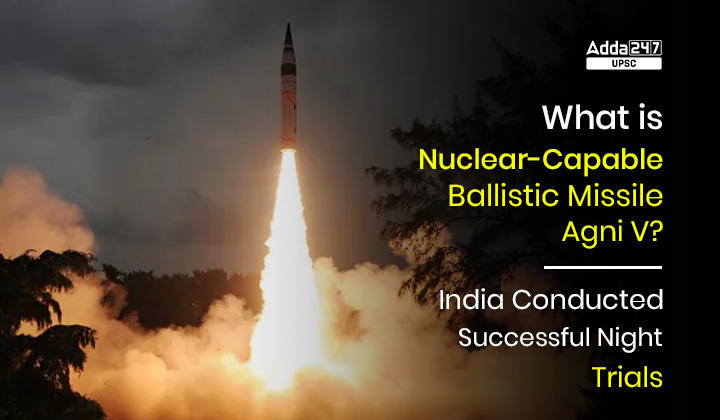Table of Contents
Relevance of Agni V for UPSC CSE
Nuclear-Capable Ballistic Missile Agni V: The latest Trial test of Nuclear Capable Ballistic Missile Agni 5 was conducted to validate new technologies and equipment on the missile, which is now lighter than it was previously. It covers GS Paper 3: Science and Technology – Achievements of Indians in science & technology; indigenization of technology and developing new technology and GS Paper 3: Internal Security.
Also Read: BrahMos Missile- Extended Range BrahMos Flight-Tested
Why Agni 5 is in News?
- India Conducted Successful Night flight test of Agni 5 missile system on December 15, 2022.
- Agni – 5 is India’s long-range surface-to-surface nuclear capable ballistic missile.
- When Agni 5 last tested?
- In October 2021, India successfully launched the surface-to-surface ballistic missile Agni-5 from APJ Abdul Kalam Island in Odisha.
- In October, Agni 5 was tested by the SFC independently for the first time, a few months after China had tested its hypersonic missile.
Also Read: PRALAY: Successful launch of surface-to-surface missile
Where did the latest Night flight test of Agni 5 missile done?
- The Strategic Forces Command (SFC), which operates the Agni 5, carried out the Night flight test from A P J Abdul Kalam Island off the coast of Odisha.
- The government had cleared massive airspace for the test launch, which spread over 5,000 kilometers.
Also Read: Astra Mk-1 Air-to-Air Missile- Features, and Strategic Significance
What is the Agni 5 missile?
Agni 5 is developed by India’s Defence Research and Development organisation (DRDO). It is a nuclear-capable missile, which uses a three-stage solid-fuelled engine.
- Background: The development of Agni missiles started in early 1980 under the Integrated Guided Missile Development Programme spearheaded by scientist and former President Dr A P J Abdul Kalam, who was also a central figure in India’s missile and space programmes.
- Varying Ranges: Medium to Intercontinental versions of Agni missile systems 1 to 5 have varying ranges — starting from 700 km for Agni-1 to 5000 km and above for Agni-5. In June 2021, DRDO successfully tested Agni P, a canisterised missile with a range capability between 1,000 and 2,000 km.
- Easy Launch: The Agni 5 missile can be launched from road and rail platforms, making it easier for it to be deployed and launched at a quicker pace.
- What Next?: People are now looking forward to its submarine version called the ‘K-5’, which is expected to be tested in the near future. Agni-6 is also said to be under development, with a range starting at 8000 km.
Also Read: Air Defence-1: Ballistic Missile Defence Interceptor
What are the significance of the successful Night Trials of Agni 5
- The successful test firing of the Agni – 5 missile paves the way for its induction into the Strategic Forces Command that takes care of India’s strategic assets
- The successful test of Agni-5 is consistent with India’s declared objective of having ‘credible minimum deterrence,’ which underlies the pledge to ‘No First Use’.
An Advanced Machine
- The Agni 5 missile has a three-stage solid-fuelled engine.
- The Agni 5 missile has a very high degree of accuracy to hit targets. It has a height of 17 metres and it is capable of carrying a 1.5-tonne warhead.
- Agni-V can bring almost the entire Asia, including the northernmost part of China, as well as some regions in Europe under its striking range. The Agni 1 to 4 missiles have ranges from 700 km to 3,500 km.
- Also, the DRDO has successfully worked on lowering the weight of the Agni 5 missile by replacing steel components with composite materials. With the weight reduction the nuclear-capable strategic missile can go beyond 7,000 kms.
Also Read: Analysis Of Sansad TV Discussion: India’s Indigenous Missile Programme
FAQs on Nuclear Capable Ballistic Missile Agni 5
Q. What is The Strategic Forces Command (SFC)?
- The Strategic Forces Command (SFC), sometimes called Strategic Nuclear Command, forms part of India’s Nuclear Command Authority (NCA). It is responsible for the management and administration of the country’s tactical and strategic nuclear weapons stockpile.
- It was created by the Vajpayee Government on on January 4, 2003.
- Air Marshal Teja Mohan Asthana became its first commander-in-chief.
Q. What is the range of Agni 5?
The range of Agni 5 is 5000 to 7000 km. With this range, Agni-V can bring almost the entire Asia, including the northernmost part of China, as well as some regions in Europe under its striking range.




 TSPSC Group 1 Question Paper 2024, Downl...
TSPSC Group 1 Question Paper 2024, Downl...
 TSPSC Group 1 Answer key 2024 Out, Downl...
TSPSC Group 1 Answer key 2024 Out, Downl...
 UPSC Prelims 2024 Question Paper, Downlo...
UPSC Prelims 2024 Question Paper, Downlo...




